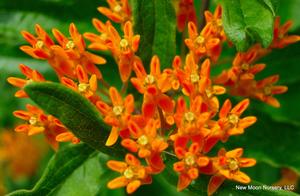Printed at http://www.newmoonnursery.com/index.cfm/

Butterfly weed provides nectar and food source for butterflies and butterfly larvae. Drought tolerant.
Asclepias tuberosa
Butterfly weed
Native to North America
FIRST IMPRESSIONS: Asclepias tuberosa is an upright perennial with oblong leaves. In summer large clusters of bright orange flowers grace the plant. Flowers attract a bevy of nectar seeking butterflies. Plants are best adapted to sunny sites with well drained or dry soil.
HABITAT & HARDINESS: Asclepias tuberosa occurs in prairies, open woods or on roadsides in eastern and central North America. Range extends from Canada to Florida and west to Arizona often on deep sandy soils.
Plants are hardy from USDA Zones 3-9.
PLANT DESCRIPTION: Asclepias tuberosa is a bushy warm season perennial with many branched pubescent stems emerging from a sturdy tap root. Unlike other milkweeds, this one does not contain milky latex sap.
The leaves are bright green and lance shaped. Summer flowers are arranged in flat topped clusters and are composed of many small star shaped florets in shades of orange and scarlet. This milkweed is a repeat bloomer that attracts butterflies, moths, bees and hummingbirds.
Young gray-green seed pods are covered in short silky hairs. The pods split when ripe and release brown seed with silken parachutes that drift away on the wind.
Plants grow 3’ tall with 3’ spread.
CULTURAL & MAINTENANCE NEEDS: Asclepias tuberosa is an easily cultivated sun loving plant for well drained or dry soils. Mistakes made in cultivation can usually be attributed to pampering the plant. Successful culture requires that the gardener duplicate the harshness of the natural ecosystems where this milkweed occurs.
Established plants are very drought tolerant but are difficult to transplant due to the taproot. They also tolerate harsh winds and controlled burns.
Recently planted plugs may need mulch to protect them from frost heaving. Asclepias tuberosa emerges from dormancy later than many so planting locations should be marked to avoid disturbance.
Asclepias tuberosa is not palatable to deer and other herbivores but all sorts of insects love it. In fact, it is almost impossible to grow milkweed without a throng of oleander aphids in residence. These tiny orange plant lice suck the plant’s sap and exude sticky honeydew that is the perfect cultural medium for black sooty mold. If this is an issue, conventional pesticides should be avoided because they often kill the highly desirable Monarch Butterfly caterpillar.
LANDSCAPE USES: This is a great choice for a Wildlife Garden, Dry Meadow or Prairie. Plants are also used as an Accent, Butterfly Nectar Plant, Butterfly Host Plant or as part of a Grouping or Mass Planting. Asclepias tuberosa provides Showy Blooms and can be used in Cottage Gardens, Deer Resistant Plantings, Water-wise Landscapes, Low Maintenance Plantings, Perennial Borders, Roadsides and Restoration Projects.
COMPANION & UNDERSTUDY PLANTS: Asclepias tuberosa mingles well with Coreopsis tripteris, Echinacea purpurea, Liatris aspera and Rudbeckia hirta.
Asclepias verticillata has similar height and habitat needs and can be substituted if needed.
TRIVIA: Asclepias tuberosa will host Monarch Butterfly caterpillars. If other milkweeds are present, however, this one is often ignored. This is probably due to the fact that this plant’s clear sap contains fewer toxins and imparts less protection to the caterpillar than milkweeds with milky sap.
Also hosts Grey Hairstreak and Queen Butterfly caterpillars.
Height:
1-3 ftSpread:
1-2 ftSpacing:
18-24 inUSDA Hardiness Zone:
4-10Bloom Color:
OrangeAsclepias tuberosa Characteristics
Attracts Wildlife
- Butterflies
Attributes
- Naturalizing
- Favorite
- Drought Tolerant
- Dried Flower
Exposure
- Full Sun to Partial Shade
Deer Resistant
- Deer Resistant
Flowering Months
- June
- July
Foliage Color
- Green
Juglans nigra Tolerance (Black Walnut)
- Yes
Salt Tolerance
- Medium
Soil Moisture Preference
- Dry
Interesting Notes:
For more information on this plant, visit the USDA PLANTS Database: http://plants.usda.gov/java/profile?symbol=ASTU
